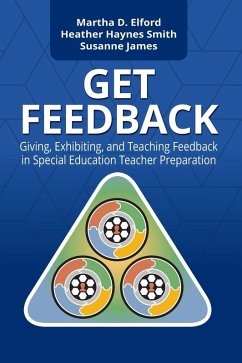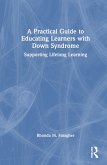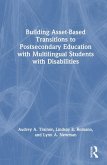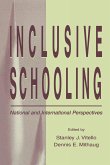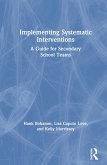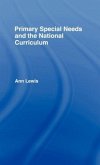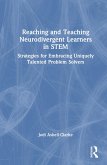Martha Elford, Heather Smith, Susanne James
GET Feedback
Giving, Exhibiting, and Teaching Feedback in Special Education Teacher Preparation
Martha Elford, Heather Smith, Susanne James
GET Feedback
Giving, Exhibiting, and Teaching Feedback in Special Education Teacher Preparation
- Gebundenes Buch
- Merkliste
- Auf die Merkliste
- Bewerten Bewerten
- Teilen
- Produkt teilen
- Produkterinnerung
- Produkterinnerung
A powerful and rich resource of great ideas that will move the debates about feedback into the most worthwhile areas.
Andere Kunden interessierten sich auch für
![A Practical Guide to Educating Learners with Down Syndrome A Practical Guide to Educating Learners with Down Syndrome]() Rhonda M FaragherA Practical Guide to Educating Learners with Down Syndrome182,99 €
Rhonda M FaragherA Practical Guide to Educating Learners with Down Syndrome182,99 €![Building Asset-Based Transitions to Postsecondary Education with Multilingual Students with Disabilities Building Asset-Based Transitions to Postsecondary Education with Multilingual Students with Disabilities]() Audrey A TrainorBuilding Asset-Based Transitions to Postsecondary Education with Multilingual Students with Disabilities206,99 €
Audrey A TrainorBuilding Asset-Based Transitions to Postsecondary Education with Multilingual Students with Disabilities206,99 €![Inclusive Schooling Inclusive Schooling]() Inclusive Schooling206,99 €
Inclusive Schooling206,99 €![Implementing Systematic Interventions Implementing Systematic Interventions]() Hank BohanonImplementing Systematic Interventions130,99 €
Hank BohanonImplementing Systematic Interventions130,99 €!['Whole-Brain' Behaviour Management in the Classroom 'Whole-Brain' Behaviour Management in the Classroom]() Chris Derrington'Whole-Brain' Behaviour Management in the Classroom183,99 €
Chris Derrington'Whole-Brain' Behaviour Management in the Classroom183,99 €![Primary Special Needs and the National Curriculum Primary Special Needs and the National Curriculum]() Ann LewisPrimary Special Needs and the National Curriculum135,99 €
Ann LewisPrimary Special Needs and the National Curriculum135,99 €![Reaching and Teaching Neurodivergent Learners in Stem Reaching and Teaching Neurodivergent Learners in Stem]() Jodi Asbell-ClarkeReaching and Teaching Neurodivergent Learners in Stem182,99 €
Jodi Asbell-ClarkeReaching and Teaching Neurodivergent Learners in Stem182,99 €-
-
-
A powerful and rich resource of great ideas that will move the debates about feedback into the most worthwhile areas.
Hinweis: Dieser Artikel kann nur an eine deutsche Lieferadresse ausgeliefert werden.
Hinweis: Dieser Artikel kann nur an eine deutsche Lieferadresse ausgeliefert werden.
Produktdetails
- Produktdetails
- Verlag: Taylor & Francis
- Seitenzahl: 344
- Erscheinungstermin: 15. Oktober 2021
- Englisch
- Abmessung: 254mm x 178mm x 21mm
- Gewicht: 812g
- ISBN-13: 9781630916916
- ISBN-10: 1630916919
- Artikelnr.: 70988510
- Herstellerkennzeichnung
- Libri GmbH
- Europaallee 1
- 36244 Bad Hersfeld
- gpsr@libri.de
- Verlag: Taylor & Francis
- Seitenzahl: 344
- Erscheinungstermin: 15. Oktober 2021
- Englisch
- Abmessung: 254mm x 178mm x 21mm
- Gewicht: 812g
- ISBN-13: 9781630916916
- ISBN-10: 1630916919
- Artikelnr.: 70988510
- Herstellerkennzeichnung
- Libri GmbH
- Europaallee 1
- 36244 Bad Hersfeld
- gpsr@libri.de
Martha D. Elford, PhD, is a Lecturer and Program Associate in the Department of Special Education at the University of Kansas in Lawrence, Kansas. Dr. Elford is the Program Designer for the online High Incidence Disabilities Teacher Education Practicum program. She has experience as a classroom teacher, a reading specialist, and an instructional coach. Dr. Elford earned her doctorate degree in Special Education at the University of Kansas as a doctoral fellow with L-TEC, Leadership in Teacher Education Core. As a post-doctoral fellow, Dr. Elford supervised the following two research projects: (a) Poses Family Foundation grant studying instructional coaching, and (b) TeachLivE, the use of simulation in teacher-preparation programs. She also has served as Educational Consultant to school districts on co-teaching, instructional coaching, and strategic instruction. Dr. Elford's research interests include the impact of feedback and coaching for pre- and in-service teachers on professional growth, using virtual coaching for teacher preparation and professional development. As a Fulbright Award recipient, Dr. Elford spent 3 months in Finland studying Finnish education and collaborating with faculty at the School of Education at both the University of Jyväskylä and the Niilo Mäki Institute in Jyväskylä, Finland. You can follow her at Vector Virtual Coaching: https://www.vectorcoaching.org/. Heather Haynes Smith, PhD, is an Associate Professor in the Department of Education at Trinity University in San Antonio, Texas. She teaches undergraduate and graduate courses on high incidence disabilities and reading instruction. Dr. Smith's research, teaching, and service support inclusion, research-based reading instruction, Response to Intervention, Multi-Tiered System of Supports, Social and Emotional Learning, service-learning, and integrated academic and behavioral supports. Prior to completing her doctorate at the University of Kansas, Dr. Smith worked in Texas as an elementary teacher, instructional coach (reading), state-level Reading Technical Assistance Specialist, project coordinator for the Higher Education Collaborative at the Vaughn Gross Center for Reading and Language Arts, and a consultant for the Meadows Center for Prevention of Educational Risk. The United Way of San Antonio and Bexar County honored her as a nominee for the Inaugural Higher Education Innovation Award in 2019. Locally, Dr. Smith serves on the United Way Successful Student Impact Council, SA Reads Board, Winston School Medical and Scientific Advisory Council, and Mahncke Park Community Garden Board. Dr. Smith is a Certified Principal, and an elementary, ESL, and special education teacher and welcomes the opportunity to collaborate on implementing reading-focused multi-tiered systems of support and instruction with schools and districts. You can follow her on Twitter @DrHaynesSmith. Susanne James, PhD, is an Associate Professor in the Department of Teaching and Learning at Southern Illinois University Edwardsville (SIUE). Dr. James is also the Project Director for the SIUE Virtual Professional Practice Lab (http://www.siue.edu/virtual-practice-lab/). In addition to her work with the SIUE Virtual Professional Practice Lab, she teaches courses in educational research, effective instructional strategies, differentiated instruction, and accommodations of core curriculum. Dr. James serves as the Program Director for the Department of Teaching and Learning Master of Arts in Teaching graduate program for those seeking an alternative route to teacher licensure in Special Education at the graduate level. Prior to completing her doctorate at the University of Kansas, Dr. James was a classroom teacher of students with special needs for 13 years within instructional and inclusion settings in Kansas and Missouri. She also has been an instructional coach and educational consultant to school districts for co-teaching, differentiated instruction, strategic instruction, and effective practices. Dr. James' research, teaching, and service supports virtual learning, co-teaching, teacher preparation, and strategic instruction. You can follow her on the SIUE Virtual Professional Practice Facebook page at https://www.facebook.com/SIUEVPP.
Acknowledgments About the Authors Contributing Authors Preface Foreword by Donald D. Deshler
PhD Foreword by John Hattie
PhD Section I The G.E.T. Model Chapter 1 Introduction and Conceptual Framework Chapter 2 Book and Chapter Organization Section II Giving Feedback Chapter 3 Audiences/Recipients of Feedback Personal Reflection contributed by Carlos A. Flores Jr.
EdDAuthentic Example contributed by Kyena E. Cornelius
EdD Chapter 4 Immediate Versus Delayed Feedback Authentic Example contributed by Kristin Joannou Lyon
PhD andVirginia L. Walker
PhD
BCBA-D Chapter 5 How We Give Feedback Authentic Example contributed by Martha D. Elford
PhD Section III Exhibiting Feedback Chapter 6 Exhibiting Feedback and the Four Domains of the G.E.T. Model Authentic Example contributed by Susanne James
PhD Chapter 7 Exhibiting Feedback: Reflecting and Planning Authentic Example contributed by Martha D. Elford
PhD Section IV Teaching Feedback Chapter 8 Rationale for Teaching Feedback Practical Application contributed by Wendy H. Weber
PhD Chapter 9 Teaching Feedback in Instruction Authentic Example contributed by Katie Martin Miller
PhD Chapter 10 Teaching Feedback in Assessment Authentic Example contributed by Ruby L. Owiny
PhD andKyena E. Cornelius
EdD Chapter 11 Teaching Feedback to Support Students' Behavioral Needs Reesha Adamson
PhD; Jessica Nelson
EdD
BCBA; and Felicity Post
EdDAuthentic Example contributed by Amy Gaumer Erickson
PhD Chapter 12 Teaching Feedback in Collaboration Authentic Example contributed by Anni K. Reinking
EdD Section V Resources Chapter 13 Comprehensive Review of the Literature on Feedback inSpecial Education Teacher Preparation Chapter 14 Templates and Additional Opportunities to Apply the G.E.T. Model Authentic Examples contributed by Heather Haynes Smith
PhD;Jennifer Porterfield
PhD and Cathy Newman Thomas
PhD;Dennis Cavitt
EdD; Randa G. Keeley
PhD; Lisa A. Finnegan
PhD; andAnni K. Reinking
EdDGlossary Financial Disclosures Index
PhD Foreword by John Hattie
PhD Section I The G.E.T. Model Chapter 1 Introduction and Conceptual Framework Chapter 2 Book and Chapter Organization Section II Giving Feedback Chapter 3 Audiences/Recipients of Feedback Personal Reflection contributed by Carlos A. Flores Jr.
EdDAuthentic Example contributed by Kyena E. Cornelius
EdD Chapter 4 Immediate Versus Delayed Feedback Authentic Example contributed by Kristin Joannou Lyon
PhD andVirginia L. Walker
PhD
BCBA-D Chapter 5 How We Give Feedback Authentic Example contributed by Martha D. Elford
PhD Section III Exhibiting Feedback Chapter 6 Exhibiting Feedback and the Four Domains of the G.E.T. Model Authentic Example contributed by Susanne James
PhD Chapter 7 Exhibiting Feedback: Reflecting and Planning Authentic Example contributed by Martha D. Elford
PhD Section IV Teaching Feedback Chapter 8 Rationale for Teaching Feedback Practical Application contributed by Wendy H. Weber
PhD Chapter 9 Teaching Feedback in Instruction Authentic Example contributed by Katie Martin Miller
PhD Chapter 10 Teaching Feedback in Assessment Authentic Example contributed by Ruby L. Owiny
PhD andKyena E. Cornelius
EdD Chapter 11 Teaching Feedback to Support Students' Behavioral Needs Reesha Adamson
PhD; Jessica Nelson
EdD
BCBA; and Felicity Post
EdDAuthentic Example contributed by Amy Gaumer Erickson
PhD Chapter 12 Teaching Feedback in Collaboration Authentic Example contributed by Anni K. Reinking
EdD Section V Resources Chapter 13 Comprehensive Review of the Literature on Feedback inSpecial Education Teacher Preparation Chapter 14 Templates and Additional Opportunities to Apply the G.E.T. Model Authentic Examples contributed by Heather Haynes Smith
PhD;Jennifer Porterfield
PhD and Cathy Newman Thomas
PhD;Dennis Cavitt
EdD; Randa G. Keeley
PhD; Lisa A. Finnegan
PhD; andAnni K. Reinking
EdDGlossary Financial Disclosures Index
Acknowledgments About the Authors Contributing Authors Preface Foreword by Donald D. Deshler
PhD Foreword by John Hattie
PhD Section I The G.E.T. Model Chapter 1 Introduction and Conceptual Framework Chapter 2 Book and Chapter Organization Section II Giving Feedback Chapter 3 Audiences/Recipients of Feedback Personal Reflection contributed by Carlos A. Flores Jr.
EdDAuthentic Example contributed by Kyena E. Cornelius
EdD Chapter 4 Immediate Versus Delayed Feedback Authentic Example contributed by Kristin Joannou Lyon
PhD andVirginia L. Walker
PhD
BCBA-D Chapter 5 How We Give Feedback Authentic Example contributed by Martha D. Elford
PhD Section III Exhibiting Feedback Chapter 6 Exhibiting Feedback and the Four Domains of the G.E.T. Model Authentic Example contributed by Susanne James
PhD Chapter 7 Exhibiting Feedback: Reflecting and Planning Authentic Example contributed by Martha D. Elford
PhD Section IV Teaching Feedback Chapter 8 Rationale for Teaching Feedback Practical Application contributed by Wendy H. Weber
PhD Chapter 9 Teaching Feedback in Instruction Authentic Example contributed by Katie Martin Miller
PhD Chapter 10 Teaching Feedback in Assessment Authentic Example contributed by Ruby L. Owiny
PhD andKyena E. Cornelius
EdD Chapter 11 Teaching Feedback to Support Students' Behavioral Needs Reesha Adamson
PhD; Jessica Nelson
EdD
BCBA; and Felicity Post
EdDAuthentic Example contributed by Amy Gaumer Erickson
PhD Chapter 12 Teaching Feedback in Collaboration Authentic Example contributed by Anni K. Reinking
EdD Section V Resources Chapter 13 Comprehensive Review of the Literature on Feedback inSpecial Education Teacher Preparation Chapter 14 Templates and Additional Opportunities to Apply the G.E.T. Model Authentic Examples contributed by Heather Haynes Smith
PhD;Jennifer Porterfield
PhD and Cathy Newman Thomas
PhD;Dennis Cavitt
EdD; Randa G. Keeley
PhD; Lisa A. Finnegan
PhD; andAnni K. Reinking
EdDGlossary Financial Disclosures Index
PhD Foreword by John Hattie
PhD Section I The G.E.T. Model Chapter 1 Introduction and Conceptual Framework Chapter 2 Book and Chapter Organization Section II Giving Feedback Chapter 3 Audiences/Recipients of Feedback Personal Reflection contributed by Carlos A. Flores Jr.
EdDAuthentic Example contributed by Kyena E. Cornelius
EdD Chapter 4 Immediate Versus Delayed Feedback Authentic Example contributed by Kristin Joannou Lyon
PhD andVirginia L. Walker
PhD
BCBA-D Chapter 5 How We Give Feedback Authentic Example contributed by Martha D. Elford
PhD Section III Exhibiting Feedback Chapter 6 Exhibiting Feedback and the Four Domains of the G.E.T. Model Authentic Example contributed by Susanne James
PhD Chapter 7 Exhibiting Feedback: Reflecting and Planning Authentic Example contributed by Martha D. Elford
PhD Section IV Teaching Feedback Chapter 8 Rationale for Teaching Feedback Practical Application contributed by Wendy H. Weber
PhD Chapter 9 Teaching Feedback in Instruction Authentic Example contributed by Katie Martin Miller
PhD Chapter 10 Teaching Feedback in Assessment Authentic Example contributed by Ruby L. Owiny
PhD andKyena E. Cornelius
EdD Chapter 11 Teaching Feedback to Support Students' Behavioral Needs Reesha Adamson
PhD; Jessica Nelson
EdD
BCBA; and Felicity Post
EdDAuthentic Example contributed by Amy Gaumer Erickson
PhD Chapter 12 Teaching Feedback in Collaboration Authentic Example contributed by Anni K. Reinking
EdD Section V Resources Chapter 13 Comprehensive Review of the Literature on Feedback inSpecial Education Teacher Preparation Chapter 14 Templates and Additional Opportunities to Apply the G.E.T. Model Authentic Examples contributed by Heather Haynes Smith
PhD;Jennifer Porterfield
PhD and Cathy Newman Thomas
PhD;Dennis Cavitt
EdD; Randa G. Keeley
PhD; Lisa A. Finnegan
PhD; andAnni K. Reinking
EdDGlossary Financial Disclosures Index

